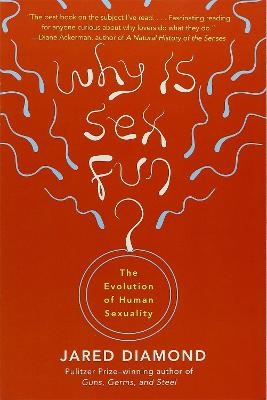
Why Is Sex Fun?
The Evolution of Human Sexuality
Seiten
1998
Basic Books (Verlag)
978-0-465-03126-9 (ISBN)
Basic Books (Verlag)
978-0-465-03126-9 (ISBN)
- Titel ist leider vergriffen;
keine Neuauflage - Artikel merken
Why do humans differ in sexuality from close animal relatives and ancestors? Jared Diamond explores the evolutionary forces that gave shape to human sexual distinctions and shows how they contributed to what it means to be uniquely human.
To us humans the sex lives of many animals seem weird. In fact, by comparison with all the other animals, we are the ones with the weird sex lives. How did that come to be?Just count our bizarre ways. We are the only social species to insist on carrying out sex privately. Stranger yet, we have sex at any time, even when the female can't be fertilized (for example, because she is already pregnant, post-menopausal, or between fertile cycles). A human female doesn't know her precise time of fertility and certainly doesn't advertise it to human males by the striking colour changes, smells, and sounds used by other female mammals.Why do we differ so radically in these and other important aspects of our sexuality from our closest ancestor, the apes? Why does the human female, virtually alone among mammals go through menopause? Why does the human male stand out as one of the few mammals to stay (often or usually) with the female he impregnates, to help raise the children that he sired? Why is the human penis so unnecessarily large?There is no one better qualified than Jared Diamond,renowned expert in the fields of physiology and evolutionary biology and award-winning author,to explain the evolutionary forces that operated on our ancestors to make us sexually different. With wit and a wealth of fascinating examples, he explains how our sexuality has been as crucial as our large brains and upright posture in our rise to human status.
To us humans the sex lives of many animals seem weird. In fact, by comparison with all the other animals, we are the ones with the weird sex lives. How did that come to be?Just count our bizarre ways. We are the only social species to insist on carrying out sex privately. Stranger yet, we have sex at any time, even when the female can't be fertilized (for example, because she is already pregnant, post-menopausal, or between fertile cycles). A human female doesn't know her precise time of fertility and certainly doesn't advertise it to human males by the striking colour changes, smells, and sounds used by other female mammals.Why do we differ so radically in these and other important aspects of our sexuality from our closest ancestor, the apes? Why does the human female, virtually alone among mammals go through menopause? Why does the human male stand out as one of the few mammals to stay (often or usually) with the female he impregnates, to help raise the children that he sired? Why is the human penis so unnecessarily large?There is no one better qualified than Jared Diamond,renowned expert in the fields of physiology and evolutionary biology and award-winning author,to explain the evolutionary forces that operated on our ancestors to make us sexually different. With wit and a wealth of fascinating examples, he explains how our sexuality has been as crucial as our large brains and upright posture in our rise to human status.
Jared Diamond is professor of physiology at UCLA Medical School and the author of The Third Chimpanzee.
* The Animal with the Weirdest Sex Life * The Battle of the Sexes * Why Dont Men Breast-feed Their Babies? The Non-Evolution of Male Lactation * Wrong Time for Love: The Evolution of Recreational Sex * What Are Men Good For? The Evolution of Mens Roles * Making More by Making Less: The Evolution of Female Menopause * Truth in Advertising: The Evolution of Body Signals
| Erscheint lt. Verlag | 25.9.1998 |
|---|---|
| Sprache | englisch |
| Maße | 137 x 203 mm |
| Themenwelt | Sachbuch/Ratgeber ► Gesundheit / Leben / Psychologie ► Psychologie |
| Sachbuch/Ratgeber ► Natur / Technik | |
| Geisteswissenschaften ► Psychologie ► Sexualität / Partnerschaft | |
| Studium ► 1. Studienabschnitt (Vorklinik) ► Histologie / Embryologie | |
| Naturwissenschaften ► Biologie ► Evolution | |
| Naturwissenschaften ► Biologie ► Humanbiologie | |
| Sozialwissenschaften ► Ethnologie | |
| Sozialwissenschaften ► Soziologie | |
| ISBN-10 | 0-465-03126-9 / 0465031269 |
| ISBN-13 | 978-0-465-03126-9 / 9780465031269 |
| Zustand | Neuware |
| Haben Sie eine Frage zum Produkt? |
Mehr entdecken
aus dem Bereich
aus dem Bereich
Zytologie, Histologie und mikroskopische Anatomie
Buch | Hardcover (2022)
Urban & Fischer in Elsevier (Verlag)
54,00 €
Gewebelehre, Organlehre
Buch | Spiralbindung (2024)
Urban & Fischer in Elsevier (Verlag)
25,00 €


